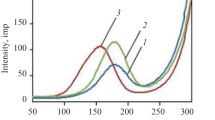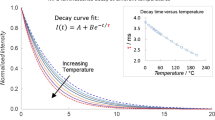Abstract
The glow curve components and thermoluminescence (TL) parameters of BeO ceramics plates with high bioequivalence were analyzed using extremely slow heating rates. Thermalox 995 was used as the BeO ceramic plates, which is a material with a BeO content of 99.5% or higher. The size of the plates was 10 × 10 × 0.7 mm3 with a density of 2.85 g/cm3, and an effective atomic number of 7.13. A linear accelerator was used for irradiation of the BeO plates at 5 Gy of 6 MV X-rays. After irradiation, the TL glow curve was measured using an in-house developed measurement instrument; the TL intensity was recorded from 50 to 400 °C with heating rates of 0.133, 0.05, and 0.005 °C/s used in three patterns. General-order kinetics were used for the theoretical analysis, which takes recapture into account. After irradiation, post-annealing was performed in the range of 50 to 350 °C at 50 °C intervals, and component analysis of the glow curves was also performed. The TL parameters were calculated from glow curves measured up to a heating rate that was three orders of magnitude slower than that previously measured. The activation energy and frequency factor for the main glow component at low temperatures were 1.15 eV and 1.11 × 1011/s, respectively, while those for the main glow component at high temperatures were 1.74 eV and 8.65 × 1013/s. The glow peak for the BeO ceramic plates were also determined have a low TL intensity component in close proximity to these two glow components. Furthermore, an increase in TL efficiency was observed when the glow curve was measured using an extremely slow heating rate. This may be due to a change of the carriers from TL-inactive when the glow curve is measured with a fast heating rate to TL-active with a longer thermal excitation time.











Similar content being viewed by others
Data availability
The research data is intended to be shared. Appropriate methods and platforms for data sharing have been prepared. Data access is based on a request basis. Researchers who wish to access the data can send a request to “shinsho@tmu.ac.jp”.
5. References
H.O. Albrecht, C.E. Mandeville, Storage of energy in beryllium oxide. Phys. Rev. 101, 1250–1252 (1956)
C.E. Mandeville, H.O. Albrecht, Luminescence of beryllium oxide. Phys. Rev. 94, 494–495 (1954)
M. Sommer, J. Henniger, Investigation of a BeO-based optically stimulated luminescence dosimeter. Radiat. Prot. Dosim. 119, 394–397 (2006)
S. Hisanaga, T. Yamashita, I. Kitamura, T. Ito, S. Kondo, Radioisotopes. 39, 381 (1990)
K. Shinsho, R. Oh, M. Tanaka, N. Sugioka, H. Tanaka, G. Wakabayashi, T. Takata, W. Chang, S. Matsumoto, G. Okada, S. Sugawara, E. Sasaki, K. Watanabe, Y. Koba, K. Nagasaka, S. Yoshihashi, A. Uritani, T. Negishi, Jpn J. Appl. Phys. 62, 010502 (2023)
S.W.S. McKeever, M. Moscovitch, P.D. Townsend, In Thermoluminescence Dosimetry Materials: Properties and Uses (1995) ISBN 1 870965 19 1
K.W. Crase, R. Gammage, Health Phys. 29, 739 (1975)
K. Becker, J.S. Cheka, M. Oberhofer, Health Phys. 19, 391 (1970)
E. Tochilin, N. Goldstein, W.G. Miller, Health Phys. 16, 1–7 (1969)
M. Tanaka, R. Oh, N. Sugioka, H. Tanaka, T. Takata, G. Wakabayashi, S. Sugawara, K. Watanabe, A. Uritani, S. Yoshihashi, K. Nagasaka, G. Okada, T. Negishi, K. Shinsho, J. Mater. Sci. : Mater. Electron. 33, 20271 (2022)
V.S. Kortov, I.I. Milman, A.L. Slesarcv, V.S. Kijko, Radiat. Prot. Dosim. 47, 267 (1993)
R.M. Baltezar, J.A. Nieto, Appl. Radiat. Isot. 150, 53–56 (2019)
K. Shinsho, D. Maruyama, S. Yanagisawa, Y. Koba, M. Kakuta, K. Matsumoto, H. Ushiba, T. Andoh, Sens. Mater. 30, 1591 (2018)
K. Shinsho, Radiation. 45(1), 29–32 (2019)
J.T. Randall, M.H.F. Wilkins, Proc. R. Soc. A 184, 366 (1945)
C.E. May, J.A. Partridge, J. Chem. Phys. 40, 1401 (1964)
K. Shinsho, K. Otsubo, Y. Koba, K. Matsumoto, H. Ushiba, Sens. Mater. Vol. 28, 917–925 (2016)
E. Bulur, H.Y. Goksu, Radiat. Meas. 29, 639–650 (1998)
G.F.J. Garlick, A.F. Gibson, Proc. Phys. Soc. Sect. A 60, 574 (1948)
E.G. Yukihara, A.B. Andrade, S. Eller, Radiat. Meas. 94, 27–34 (2016)
Author information
Authors and Affiliations
Contributions
All authors contributed to the study conception and design. Material preparation, data collection and analysis were performed by ES, NS, WC, SM, TN, KN, SY, AU, KW, GO, YK, and KS. The first draft of the manuscript was written by ES and KS, and all authors commented on previous versions of the manuscript.
Corresponding author
Ethics declarations
Competing interests
All the authors have no conflicts of interest to declare.
Ethical approval
No human participants/animals are involved in this study. Since the authors have nothing to declare and no human participants/animals are involved in this study, no informed consent is needed.
Additional information
Publisher’s Note
Springer nature remains neutral with regard to jurisdictional claims in published maps and institutional affiliations.
Rights and permissions
Springer Nature or its licensor (e.g. a society or other partner) holds exclusive rights to this article under a publishing agreement with the author(s) or other rightsholder(s); author self-archiving of the accepted manuscript version of this article is solely governed by the terms of such publishing agreement and applicable law.
About this article
Cite this article
Sasaki, E., Sugioka, N., Chang, W. et al. Precise thermoluminescence glow curve analysis of BeO ceramic plates with slow heating rates. J Mater Sci: Mater Electron 34, 2060 (2023). https://doi.org/10.1007/s10854-023-11378-7
Received:
Accepted:
Published:
DOI: https://doi.org/10.1007/s10854-023-11378-7




